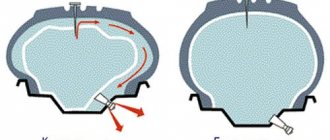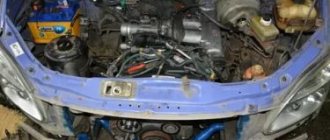Sergey Ukhov, photo by the author
The Nizhny Novgorod "one and a half" GAZelle, popular among carriers, has a good margin of safety, thanks to the frame structure and reliable chassis, but often causes complaints from owners regarding the power unit. Serial gasoline cars are not satisfied with their slowness and gluttony, while diesel cars are complex and expensive to operate. Therefore, private companies installing alternative engines under the hoods of GAZelles are becoming increasingly popular.
Matters of the heart
Over the 22-year conveyor life of the Nizhny Novgorod “one and a half”, quite a few different engines managed to work in its engine compartment, starting with gasoline Rover 20T4 / V8 MPI, DCC EDZ (Chrysler 2.4 DOHC), ZMZ, UMP and ending with diesel engines GAZ-560 (Steyr), ZMZ-514 and Cummins ISF 2.8. And these are only mass-produced units, and how many more experimental, experimental and converted versions were generated both by the plant itself and by countless private service stations and tuning studios...
Acting empirically, in the late 1990s, experts came to the conclusion that one of the most optimal engine options for GAZ passenger cars and light commercial vehicles is the product of the Japanese company Toyota. Numerous tuning shops operating at the Gorky Automobile Plant at that time, "Celeste"), began to re-equip Volgas, Sobols and GAZelles on individual orders, installing more powerful 6-cylinder Toyota engines on them. One of the most famous in this area was, which still exists today, however, tuning GAZ cars has not been its main business for a long time.
But if in any search engine on the Internet today you type the query “Toyota engine for GAZelle”, many companies that continue the work of Technoservice will appear in the list of results. But if 10-15 years ago the Japanese power units installed on gas cars cost incredible amounts of money, today components come from Japan in the form of used “contract parts”. In addition, the engines were installed mainly on new GAZ cars, which required certification and registration. And today, engine changes are often carried out on used cars only under a re-equipment certificate.
The latter circumstance became possible thanks to Order No. 20152 of the Ministry of Internal Affairs of Russia dated March 17, 2011, according to which the verification of engine numbers of vehicles with a gross weight of up to 5 tons in the traffic police was canceled. This point still causes numerous disputes and various legal consequences in the traffic police. But this is already a question of the imperfection of legislation and the lack of uniformity in law enforcement.
Classifying an engine as a numberless part has freed up the hands of vehicle tuning companies, and the “registration” of alternative engines under the hood of GAZelles has recently been gaining popularity. With the assistance of Nizhny Novgorod, I watched the process of converting a GAZelle from a basic power unit to an alternative one and even took a ride in one of the “one and a half” with the heart of a samurai.
From a noble family
As noted, the increasingly popular trend of transplanting imported hearts into domestic cars in the vast majority of cases occurs not with new cars, but with used ones. The base engine of such a car is either pretty worn out and requires expensive repairs, or has completely exhausted its service life. And due to the disappearance of bureaucratic control over the power units used in registered vehicles, owners are trying not only to replace a failed standard engine with a more powerful one, but also to ultimately obtain improved dynamics, comfort and an increased service life. In this regard, time-tested 6-cylinder Toyota engines with an in-line and V-shaped cylinder arrangement, the legendary JZ and VZ series, respectively, deservedly take their place under the hood of GAZelles, Soboleys, Barguzinovs and Volgas.
The practice of using these engines in Japanese and American business and executive class cars Toyota Mark II, Aristo, Crown, Cresta, Chaser, Lexus GS300 and others has more than once demonstrated record reliability and a service life of one million kilometers, unattainable for modern ultra-eco-friendly turbo engines. The safety factor built into these engines and the versatility of use (from business class sedans to full-fledged SUVs) made it possible to place these power units even in light commercial vehicles. Moreover, the original Aisin automatic transmission, which comes complete with Japanese engines, is installed along with the engine.
Let me note right away that the Toyota engines used are not new and have already worked in the engine compartments of the listed Japanese Toyota and Lexus cars, but without being driven in the Russian Federation. As representatives of the Nizhny Novgorod installation company note, they have a reliable supplier who selects engines with an average mileage of 70–80 thousand kilometers. Considering that the 1JZ GE and 2JZ GE series are designed for a million kilometers, the declared mileage is less than 10% of their resource. The Aisin 4-speed automatic transmission that comes with the engine is also designed for approximately 300 thousand km, but judging by the reported mileage, they still have 3/4 of the service life remaining.
A remark should be made: no one carries out a technical examination of incoming motors, and the installer company itself, in addition to the standard procedure for changing technical fluids, timing belts, spark plugs and filters, due to saving time and money for the customer, does not check the condition of the pistons (CPG), valves (GRM) ) and crankshaft (KShM). Therefore, according to Russian legislation, the customer has exactly 14 days after the conversion to verify the functionality of the components and assemblies installed on his car.
There is a direct dependence of the resource of the power unit on the nature of the subsequent operation of the GAZelle, as well as on the regularity of maintenance and the quality of the lubricants and fuel used. But even in the case of not the most diligent and careful operation, you can count on the fact that the automatic transmission will save the engine better than the average driver operating a manual transmission, simply because a serviceable Aisin automatic transmission torque converter will not allow shock load on the engine, which occurs in cars with a manual transmission. moment of releasing the clutch pedal.
Especially for normal operation of the power unit, the installer retains the factory engine and gearbox control units, as well as their factory settings.
Japanese engine and automatic transmission for GAZelle: what to look for
In the case of the GAZelle, many drivers seek to modify and modify the car to improve various characteristics, as well as to increase the level of reliability and comfort.
One of these radical decisions is the desire to install an imported engine with a gearbox on the GAZelle. Moreover, this method allows you to install an automatic transmission on a Gazelle, which is also a fairly popular option.
Taking into account the fact that a huge number of spare parts enter the territory of the Russian Federation from the Far Eastern region, and the engines themselves, gearboxes and other units from Japan are deservedly considered “indestructible”, for obvious reasons the choice often falls on them.
In simple words, a competent approach and relatively small investments make it possible to equip a GAZelle with a reliable Japanese gasoline or diesel engine, as well as a manual or automatic transmission.
It is quite obvious that such a solution has many advantages:
- It becomes possible to significantly improve the acceleration dynamics, the torque becomes higher. The increase in power allows you to confidently overtake on the highway, as well as drive at higher speeds. At the same time, it is possible to reduce fuel consumption, since Japanese engines are more productive and economical.
- You can install either a gasoline engine (which, if necessary, is additionally equipped with LPG) or a diesel engine.
At the same time, the high reliability of Japanese units can significantly reduce the cost of spare parts and consumables (breakdowns occur less frequently, spare parts cost almost the same compared to the prices of parts for domestic internal combustion engines). We can also talk about the higher profitability of such modified commercial vehicles (the vehicle does not stand idle for frequent repairs). - Comfort and ease of use are increased thanks to the ability to install an automatic transmission in a GAZelle paired with the engine. In fact, with an automatic transmission, a domestic budget truck becomes comfortable, reliable and easier to drive.
The main thing is to correctly calculate the possibility of installing units on a car with minimal intervention. You also need to separately take into account power, torque and other characteristics, as well as subsequent loads on the engine and transmission during operation.
For example, installing an engine with a large “reserve” of power (V6 engines) may not be as rational as it seems at first glance. The fact is that too powerful a motor with high torque leads to failure of standard axles, gearboxes and other elements of the Gazelle transmission. The load on other systems (for example, the braking system) also increases.
As for the automatic transmission, this solution is suitable if the car is used mainly in the city, but the operating conditions are not too severe. The reason is that the automatic machine does not “like” overloads, slipping, etc. Considering that engines and automatic transmissions in GAZelles are often installed from lighter cars (often passenger cars), then you need to take into account the weight of the GAZelle, as well as the maximum loads when transporting goods.
- Taking into account the above, the optimal scheme can be considered the installation of a small and simple naturally aspirated 4-cylinder engine of up to 3.0 liters and a power of up to 170 hp. paired with a hydromechanical automatic transmission. By the way, Toyota and Nissan engines are in great demand and popularity for the Gazelle, and older designs at that.
Japanese engines of the 90s are highly reliable and have a long service life, they have cast iron cylinder blocks, a timing chain drive (does not require constant attention), etc. Automatic transmissions paired with such engines are also simple, 4-speed, have a long service life, are not so demanding on the quality of transmission oil, are not very susceptible to overheating, etc.
If we compare such internal combustion engines with a standard Gazelle engine (for example, 406 or 409), the Japanese engine is more powerful, better balanced, the unit is more reliable, and has a longer service life. At the same time, its power is not “excessive”, that is, it will not quickly damage other elements of the transmission.
An automatic transmission (subject to compliance with the rules for operation and maintenance) can easily cover 200-250 thousand km. without the need for any repairs. At the same time, the automatic transmission selector is quite easily integrated into the Gazelle’s interior. The convenient location of the automatic transmission lever makes it easier for the driver to interact with the gearbox.
Simple implantation
The entire conversion process takes two weeks, and in the case of the one we are describing, it takes place on its technical base. From the GAZelle provided by the client, the entire power unit is removed, including the engine with wiring and all attachments, a gearbox with a lever in the cabin, as well as a driveshaft, the original control unit (MIKAS), fastening elements, an exhaust and a cooling system. All this is given to the client, although it would be nice if the company took the removed parts for sale or disposal, thereby providing the client with an additional discount. So next to the tuners there is a place for a business selling illiquid goods!
In the vacated engine compartment, new mounting points are installed for the Japanese power unit, an engine with an automatic transmission is installed, and new wiring is laid. A new driveshaft is made individually for each car, since onboard GAZelles are often lengthened outside the factory and they have completely different wheelbase sizes, and when installing a different power unit, the distance from the gearbox output shaft to the rear axle gearbox changes. On some cars, the rear axle gearbox is also changed to a faster one. Certain changes are also made to the front facing panel of the cabin, on which a new engine radiator and automatic transmission heat exchanger are mounted, and a pair of electric fans are mounted in front of them.
Certain changes are also taking place inside the car.
In place of the long gearbox poker, a high podium is placed on the floor (to the level of the seat cushions), on which the Toyota automatic transmission selector is mounted. The inadequate set of pedals in the driver’s feet also looks unusual, since the clutch pedal is removed as unnecessary. In some customer cars, the native “Gazelle” instrument cluster is also replaced with an original one from Toyota, the speedometer of which is marked up to 180 km/h, and in the middle there is an indication of the selected transmission mode. Comparative characteristics of engines
| Engine | UMZ-4216 | Cummins ISF 2.8 S3129T | Toyota 1JZ-GE | Toyota 2JZ-GE | Toyota 5VZ-FE | Toyota 1UZ-FE |
| Years of manufacture | Since 2003 | Since 2009 | 1997–2007 | 1997–2007 | 1993–2004 | 1997–2002 |
| Type | I-4, gasoline | I-4, turbodiesel | I-6, gasoline | I-6, gasoline | V-6, gasoline | V-8, gasoline |
| Working volume, cm3 | 2890 | 2781 | 2492 | 2997 | 3378 | 3969 |
| Compression ratio | 8,8 | 16,5 | 10,5 | 10,5 | 9,6 | 10,4 |
| Power, hp | 123 at 4000 | 120 at 3200 | 200 at 6000 | 220 at 5800 | 190 at 4800 | 290 at 5800 |
| Torque, N∙m | 240 at 2200–2500 min-1 | 297 at 1600–2700 min-1 | 251 at 4000 min-1 | 280 at 4800 min-1 | 298 at 3600 min-1 | 407 at 4100 min-1 |
| Average fuel consumption, l/100 km | 10,7–14* ? | 8,5–10,3 | 9,8–15 | 10,5–18 | 11,1–20 | 9,2–17,4 |
| Engine weight, kg | 170 | 214 | 207 | 230 | 190 | 265 |
| Engine life, km | 300 000 | 500 000 | 1 000 000 | 1 000 000 | 1 000 000 | 1 000 000 |
Depending on the model, the nature of operation and the wishes of the client, the appropriate engine is selected. Volgas, Sobols and GAZelles that are not fully loaded are traditionally equipped with a 2.5-liter 200-horsepower Toyota 1JZ GE. For more heavy-duty GAZelles, a 3-liter 230-horsepower 2JZ GE is used, and for operation with overload or for hurricane dynamics, a 190-horsepower V6 5VZ FE and even a 260-horsepower V8 1UZ FE are used. By the way, the V8 comes with a 5-speed automatic transmission.
Of course, the more complex and powerful the engine, the higher the price of its installation. The minimum cost of turnkey work is 170 thousand rubles (taking into account the May exchange rate). But, for the “marriage” of a power unit with all-wheel drive, an additional payment of around 40 thousand rubles is required, and another 5 thousand for installing a Toyota dashboard. They will also install air conditioning, an original exhaust system, power steering (if it was missing before), etc. for free.
But judging by the reviews of GAZelle owners who installed Toyota JZ, the operation is worth it.
Stung "one and a half"
A short introductory test of the converted lorry made it clear why their owners are so happy. Until the engine starts, the only things that confuse the interior of the converted GAZelle are the unusual automatic transmission selector in place of the “poker” and the absence of a clutch pedal. Therefore, instead of using the clutch when starting, I depress the brake pedal and... Oh, miracle! Instead of the usual sluggish activation of the starter, the smooth bass of a perfectly balanced multi-cylinder engine comes from under the hood. Without spinning up to 2.5–3 thousand rpm, the JZ does not allow itself to be identified by its sound. And the silence in the cabin, which is not typical for the Nizhny Novgorod “one and a half”, and the lack of vibrations first makes you look at the tachometer needle to make sure whether the engine is running.
But we can’t wait to test his work in action. To do this, I move the automatic transmission selector to the Drive position and release the brake pedal, and the car, like a passenger car “on automatic,” begins to move without pressing the accelerator, providing an acceptable speed for careful maneuvering in tight yards. But, having left the territory of the service center, the Japanese power unit demonstrates other sides of its character: the acceleration dynamics even with the accelerator pedal pressed halfway are impressive. This is how modern passenger cars accelerate, unencumbered by a frame, rear axle and a 5-meter tent body. If you want to start sharply or make the fastest possible acceleration, there is a “kick-down” button under the accelerator pedal, which brings the engine to maximum output and keeps the speed in the range of 4.5–7 thousand. In such modes, even with a non-original exhaust system, the sound of the JZ engine cannot be confused with anything.
The Japanese power unit is not hampered in any way by the GAZelle Business dependent suspension and the GAZelle Next independent suspension. There is about 30 cm left from the engine crankcase to the ground, but even if it is damaged, replacement will not cost a pretty penny, since the pan is not aluminum, but steel
According to owners who already operate GAZelles with a JZ engine and automatic transmission, the fuel consumption of an empty car in urban conditions is 11–12 liters per “hundred”. With a total weight of 3.5 tons, it increases by about 1/3, but still does not exceed the values of the outdated 4-cylinder UMZ-4216.
But I had the opportunity to drive the most modest 2.5-liter version of the Toyota 1JZ GE and not the lightest GAZelle. It’s even scary to imagine what kind of dynamics the lightweight Sobol with a 260-horsepower V8 1UZ FE demonstrates.
And yet, despite all the advantages of the GAZelle with a Toyota engine, compared to a serial gasoline car, I came to the conclusion that these cars cannot become mass-produced. To drive a commercial vehicle with more than 200 horsepower with dependent rear suspension, without ASR and ESP, you need to have the highest driving qualifications. And with a novice and spirited driver behind the wheel, such a 3.5-ton car will be extremely dangerous for others.
How to install on GAZelle
To install a Toyota engine on a GAZelle, you must perform the following steps:
- We install the vehicle on a special platform for repair work or on an inspection pit.
- We fix the wheel mechanisms with special stoppers.
- Disconnect the manual transmission. To do this, you need to remove all the mounting bolts.
- We dismantle the coupling mechanism by unscrewing the fasteners from the casing and completely removing the entire assembly.
- Remove the crankshaft drive pulley using a screwdriver and wrench. Before starting the procedure, you need to fix the crankshaft in the highest dead center position.
- We dismantle the flywheel using a gas wrench.
- Remove the timing belt and chain. Before removing the belt, it is recommended to loosen the chain by removing the tensioner.
- We dismantle the block of cylindrical elements by unscrewing all the fastening nuts. First you need to remove the cover, then you can start dismantling the entire unit.
- We install the new power unit by performing all the steps in reverse order.
Installation and replacement of the engine on a GAZelle is carried out only in special protective clothing (mask and goggles).











